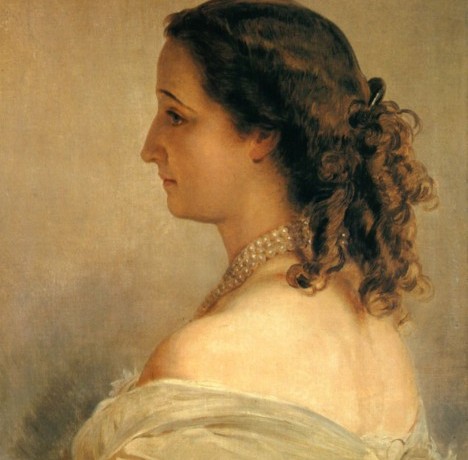On the 5th May 1826: María Eugenia Palafox Portocarrero and Kirkpatrick, Countess of Teba and better known as Eugenia of Montijo was born in Granada, in the area of ‘la Magdalena’,. She is our “Vintage Icon” for May.
She is the daughter of Cipriano Palafox and Portocarrero, ‘Grande de España’, and of Maria Manuela Kirkpatrick and Grevigné, the granddaughter of the fourth Countess of Montijo, Maria Francisca of Sales Portocarrero.
An inheritance distances Eugenia from her natalGranadaand drives her into the world of wealth and privilege that her mother had always dreamed of for her daughters. It is in 1830 when her family inherits the Montijo title for which they are known, and move toMadrid.
Maria Eugenia was a beautiful, cosmopolitan and passionate young girl, being due to this thatSpain’s “best catches” fell at her feet. All apart from the only one she loved, the Duke of Alba, who preferred her sister Paca, who was nearly as beautiful as her but more sensible and mature, and managed to capture him ending in their marriage in 1845.
Hurt by her own love, Eugenia sets herself up to conquest the proud Napoleon III and capture the Imperial crown ofFrance. In order to do this she moves to France with her mother, a tremendously ambitious woman.
They say that she managed to conquest the Emperor in her bid to conserve her virginity, and his desire to be the first to take it. The Emperor asked Maria Eugenia “the way to her bedroom” she answered decidedly: “By passing through the chapel, sire”. This was how she managed to capture the Empress’ Crown and become one of the most influential women of her time.
The chronicles say that the Emperor was already unfaithful to her during the honeymoon; however it seems that it didn’t really matter to her. She wasn’t all that in love with him; she married him in order to gain the power and status that would convert her into the Empress of France.
Maria Eugenia didn’t waste any time during her days inFrance, she contributed greatly in convertingParisinto the City ofLight. Amongst other things she also promoted the city’s drainage works. She was an amazingly advanced woman for her time, she fought for women’s rights, succeeding in the Legion of Honour being rewarded for the first time to a woman and she advocated for women’s suffrage. She financed the opening of theSuez Canalat an international level and supported Luis Pasteur’s investigations, those which would lead to the discovery of the vaccine against rabies…In other words, a fine example of a Twenty-first century woman found in the mid Nineteenth century.
A tremendously coquettish and vain woman, she discovered the Genius fashion designer Worth and dictated the fashion during decades. She designed the crinoline, the perfume, the ‘Chatone’ necklaces and the make-up.
In 1870 following the collapse of the Second Empire she moved toEngland, this was where her husband would pass away three years later. After his death, the Empress did not keep up her efforts to create a political party or gain sufficient support for her son to get the French throne back. Her labours were in vain. In 1879 the Prince died fighting forEngland. The Empress was broken hearted but would still outlive her son by 40 years, dying finally inMadridin 1920 at 94 years of age.
Maria Eugenia of Montijo is buried in the Imperial crypt together with her husband and son.
In her will she named her inheritor to be Hernando Stuart Fizt James and Falcó, the brother of the Duke of Alba, Count of Montijo and Duke of Peñaranda.
Currently thecountyofMontijois found in the possession of Jacobo Hernando Fitz-James Stuart and Gómez, the grandson of an uncle to the current Duchess of Alba.
There are two interesting books written about the Empress’ life:
“La pasión Imperial” by Pilar Eyre, and “Eugenia de Montijo” by Genevieve Chauvel.
Finally I will leave you a link to a stunning report about Maria Eugenia’s palaces, who the French call “The Marie Antoinette of the Third Empire”. It is in French but the images are so pretty that it is worth watching.







